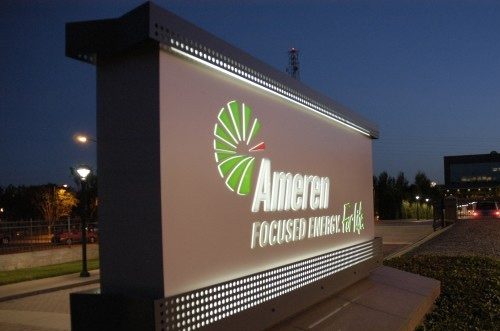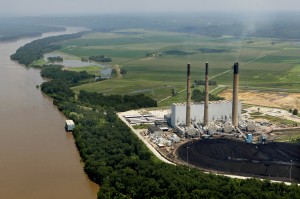
Ameren Missouri filed a request Thursday to raise electric rates by nearly 10 percent, the sixth time since 2006 the state’s largest utility has sought a general rate increase.
The St. Louis-based utility is seeking permission from its regulator, the Missouri Public Service Commission, to increase rates by $264 million.
If the PSC grants Ameren the full request, the typical household would pay about $10 more a month in utility bills. The rate case process takes almost a year as the commission undertakes a complete audit of Ameren’s cost of service, and consumer and opposing groups get involved. Ameren expects a decision by May of next year and rates to become effective by June 2015.
Rate increases over the last several years have increased the utility’s overall rates by about 42 percent, not including the smaller changes that adjust rates based on fluctuating fuel costs. Since 2006, Ameren Missouri’s base operating revenue from rates has risen from just more than $2 billion to more than $3 billion, according to the utility’s filings with the PSC.
Rates will have risen more than 50 percent since 2006 if the PSC grants the latest request in full. In recent years, the regulator has approved Ameren’s rate increase requests, but a lower amount than originally proposed by the utility.
About half of Ameren’s request is to recover higher net fuel costs, which the utility says are mostly driven by lower prices for the wholesale electricity it sells to other utilities. The utility uses these sales to partly offset costs to its Missouri customers.
Ameren also cited the money it has put into Missouri’s renewable energy mandate and the cost of complying with stricter Environmental Protection Agency rules on coal-fired power plant pollution. It says it also has to invest millions into replacing aging infrastructure such as substations and power lines.
“Those three primary drivers continue to drive up the cost of service,” said Warren Wood, Ameren’s vice president of external affairs and communications.
In addition, the utility listed increased costs from taxes and costs it expects to incur when it shuts down its Meramec coal plant in south St. Louis County by 2022.
In addition, it is requesting a higher percentage return than what is currently allowed by the commission. Right now, Ameren is allowed a 9.8 percent return on equity; it’s seeking 10.4 percent.
Wood said the request was based on the average return among investor-owned utilities throughout the country. “We have to be able to attract investment, obviously, to be able to invest in more clean renewable energy,” he said.
Ameren’s rate increase was expected, with Ameren alluding to it for months. Customer groups criticized the request.
“I think like all other ratepayers for Ameren, I look at the request from a place of pretty profound skepticism,” said Acting Public Counsel Dustin Allison, whose office advocates on behalf of ratepayers in front of the commission.
The Fair Energy Rate Action Fund, or FERAF, which counts consumer groups as well as large industrial power users among its members, accused Ameren of purposely filing the request just before the holiday weekend, when it “expected fewer Missourians to be paying attention.”
“Missourians simply can’t afford to pay 50 percent more for electricity than they did seven years ago,” FERAF executive director Chris Roepe said in a statement. “We look forward to aggressively opposing this unwarranted rate hike because of the damage it would do to Missouri’s families and economy.”
The increase is almost the same for all of the utility’s customers, which are charged different rates based on how much electricity they use. Industrial and larger commercial customers would see about the same 9.7 percent increase as households. General rates last increased in January 2013, when Ameren won a 10 percent, $259.6 million increase from its regulator.
What’s different this time, however, is Ameren’s rate increase is being filed at the same time it is defending against an overearnings complaint filed by its largest customer, Noranda Aluminum.
That case, filed at the beginning of the year, seeks a reduction in rates and accuses the utility of earning $67 million more than it should have during late 2012 through September 2013.
Noranda has filed a separate request ask for a lower individual rate. Noranda consumes about 10 percent of Ameren Missouri’s power, and it has its own electric rate as a result.
PSC Chairman Robert Kenney said there was little to no precedent for a rate increase and overearnings case occurring simultaneously, but he expected the two to have little influence on each other. Hearings begin on the overearning case at the end of this month and a decision is expected in September.
“To a certain degree there shouldn’t be too much overlap, and I would imagine the decision in the (overearnings) case would come in before the rate request case,” he said. “I think that what we will have to do is weigh the evidence in each case on their own merits.”
Joan Bray, who heads the Consumers Council of Missouri, said she thought the timing of Ameren Missouri’s rate filing was influenced by Noranda’s overearnings complaint as well as its request for a lower individual rate.
“I would think it certainly might be considered a defensive tactic,” she said.
There’s good evidence that the utility is earning more than the rate set by the PSC, she said, and it is “interesting” Ameren would say it needs more money. “There’s a case going on right now, and it should be allowed to play out.”



